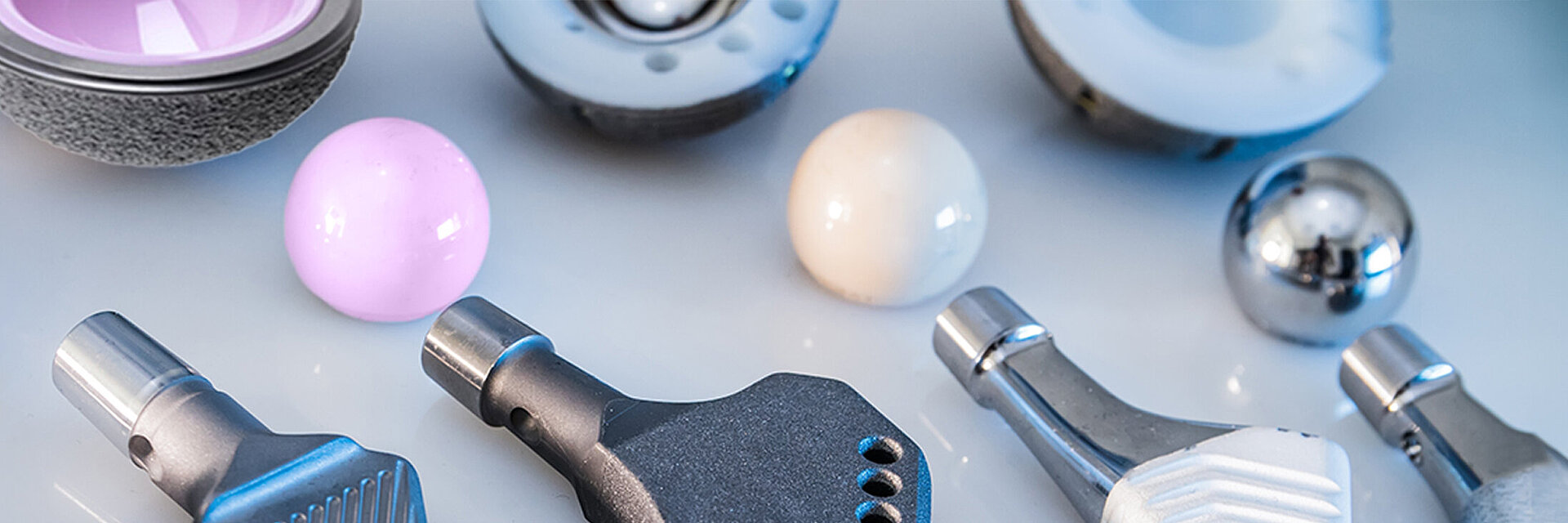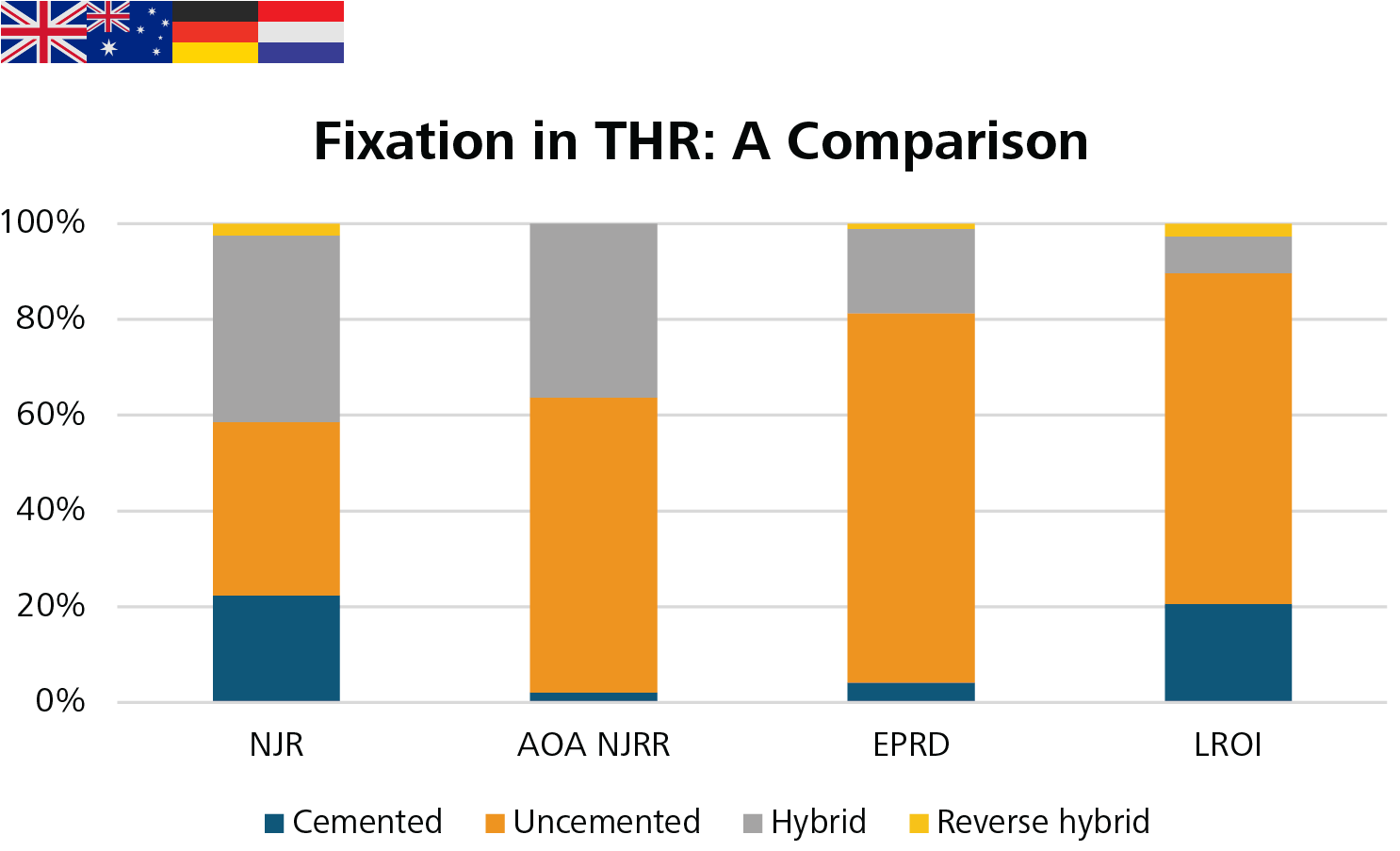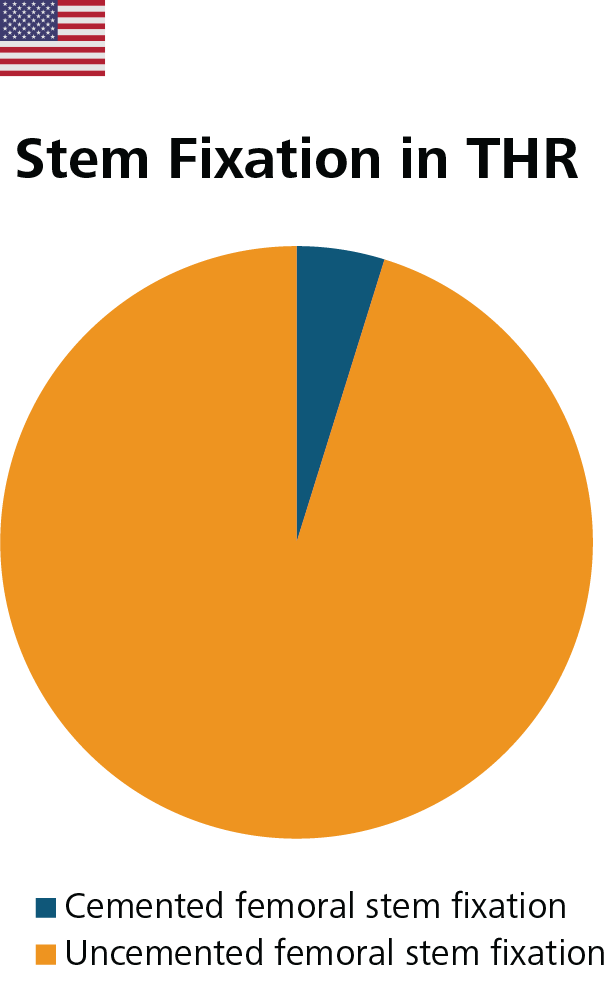Executive Summary
This summary takes the most relevant information about total hip arthroplasty procedures from the 2022 annual reports of seven national arthroplasty registries (NJR, AOA NJRR, EPRD, AJRR, NZJR, SAR and LROI). These registries have been selected as they have been defined as the most relevant, in terms of the number of procedures recorded, and the quality of the data collected.
- Across all seven registries, the impact of the COVID-19 pandemic on the volume of hip replacements eased in operation year 2021.
- In 2022, the NJR and AOA NJRR have began introducing PROMs in a separate section, reporting PROMs at the implant brand level however is still in development.
- A trend toward hybrid fixation can be observed in six national registries, apart from the AJRR.
- When only considering femoral head diameter in THR, 32mm is the most common head size according to the European registries and NZJR, whereas the AOA NJRR and AJRR report a larger usage of 36mm heads.
Ceramic - According to annual data, 51% of all THR recorded in the NJR, 89.4% in the EPRD, 27% in the SAR, and 72.8% in the LROI were performed with ceramic femoral heads. This accounts for an increase of more than 3% in the NJR, 0.3% in the EPRD, 1% in SAR, 3.9% in the LROI compared to 2020. 2021 was the first year in which the use of ceramic femoral heads exceeded that of metal femoral heads in the NJR. The AJRR reported cumulative data of ceramic femoral heads usage (2012-2021) at 76.3% in 2021, with a 3% increase from 2020. The use of CoP bearings has generally increased in 2021. CoP has become the most preferred bearing option of THR in the NJR, EPRD, AJRR, NZJR and LROI. The increased use of CoP bearings is mainly at the expense of MoP and CoC bearings.
Dual Mobility - A steady increase in use for primary THR and revision procedures can be observed. The NJR is currently the only registry reporting the use of ceramic heads with dual mobility constructs, and almost one-third of the total dual mobilities implanted in a primary procedure in 2021 had a ceramic head. The NJR confirms that the CoPoM dual mobility bearings show lower revision trend than the MoPoM combinations, but with no statistical significance.
Resurfacing - 298 CoC hip resurfacing (ReCerf®/MatOrtho®) procedures have been documented by the AOA NJRR with a cumulative revision rate of 0.3 (0.0, 2.5) at 1 year, which has a lower rate of revision compared to two MoM resurfacing systems at 1 year, with 1.1 (0.7, 1.5) and 1.4 (1.2, 1.6), respectively.
Revision - Of the most common reasons for revision, (aseptic) loosening, infection, dislocation and (periprosthetic) fractures top the list in varying order. Infection has become the most common reason for all revision procedures in Australia (22.7%, 1999-2021) and the United States (20.1%, 2012-2021). Revision rates for infection in other registries have been increasing year on year. According to the NJR, the revision rates for CoP bearings remain consistently low or equivalent to those of other bearings in all fixation options up to fifteen years. Notably, the NJR shows that good results were obtained with CoC and CoP bearings in young patients. The AOA NJRR shows a statistically significant lower rate of revision of CoXLPE in comparison with MoXLPE after 1.5 years (HR=0.79 (0.74,0.84), p<0.001). According to the EPRD, among all bearing couples, CoC show in the short-, and mid-term, the lowest failure rates. Regardless of the fixation method, the NZJR shows that the revision rate for CoC bearings is lower than that for CoP and MoP. The revision rate for CoP is also lower than that of MoP.
General Information of National Joint Registries

Evaluation of the data by CeramTec based on the demographic information provided by Annual Reports 2022 of NJR1, AOA NJRR2, EPRD3, AJRR4, NZJR5, SAR6 and LROI7.
1 Over 2.8 million procedures from 1,251 institutions in all 50 states and the District of Columbia are recorded by end of 2021.
* Indicates single year data only generated in 2021.
Table 1: General information of national joint registries.
Fixation and Bearings in Hip Replacement
A clear overall trend toward hybrid fixation can be observed in all six identified national registries at the expense of cemented fixations, except the AJRR, which categorizes fixation methods into uncemented and cemented fixation stem groups.
Uncemented fixation remains the most often used method in Australia, Germany, United States, New Zealand, and the Netherlands. The use of cemented fixation has decreased year on year in Sweden but still accounts for 52% of all THR procedures.
The usage of hybrid fixations recorded by the NJR and AOA NJRR achieved 38.1% and 36.3%, respectively. Hybrid fixation is the most popular choice for hip replacement recorded by the NJR.
According to the annual data in 2021, 21.8% of primary hip replacements have been recorded in the NJR dataset as cemented fixation, 35.4% as uncemented fixation, and 38.1% as hybrid fixation. Between 2006 and 2021, the usage of cemented fixation in all hips has decreased by almost half, while the percentage of hybrid fixation has increased by more than 2.5 times.1
There is a continuing trend in favour of uncemented fixation in Australia, from 51.3% in 2003 to 60.8% in 2020, then 61.6% in 2021. The percentage of hybrid fixation decreased slightly from 36.8% in 2020 to 36.3% in 2021, while the numbers for cemented fixation decreased significantly from 13.9% in 2003 to 2.4% in 2020, then 2.1% in 2021.2
Considering the procedures recorded in the registry dataset with the type of fixation, uncemented fixation remains the clear favorite despite a slight reduction from 78.6% in 2019 to 77.9% in 2020, then 76.9% in 2021. Hybrid fixation increased from 15.2% in 2019 to 16.8% in 2020, then 17.5% in 2021.3
In the United States, uncemented femoral stem fixation remains the preferred option. According to the statistical data for operation year 2021, it was used in 95.2% of all elective primary THR procedures from 2012 to 2021. The highest use, so far, of cemented femoral stems was recorded at 4.8% in 2021 by AJRR.4
The use of cemented fixation has decreased every year over the past 20 years until 2020. In 2021, a small increase in the proportion of patients with cemented fixation is recorded, from 50% to 52%. The increase of cemented fixation has mainly taken place in the age groups of 65-74 years and 75-84 years. The registry continues to encourage the use of cemented fixation in patients older than 70 years. The proportion of hybrid prostheses has increased from 7.1% in 2020 to 8% in 2021.6
The uncemented fixation remains, in 2021, the preferred fixation in the Netherlands, with a continuous increase from 62.6% in 2012 to 69.1% in 2021. The use of cement fixation has therefore respectively decreased slightly every year to 20.5% in 2021. There is a trend of increasing use of hybrid fixation from 4.1% in 2012 to 7.7% in 2021.7
Evaluation of the data by CeramTec is based on NJR Annual Report 2022 Page 49 Table 3.H211, AOA NJRR Annual Report 2022 Page 49 Figure HT322, EPRD Annual Report 2022 Page 28 Table 53, and LROI Annual Report 2022 Page 17 Figure Fixation7. For the comparison of THR fixation methods, unconfirmed data and all resurfacing data were excluded when analyzing datasets from the NJR, EPRD and LROI. The usage percentage of cemented, uncemented, hybrid and reverse hybrid fixations sum up to 100%.
THR by Femoral Head Diameter
When only considering femoral head diameter in THR, 32mm femoral heads are the most common head size according to the included European registries and NZJR, whereas the AOA NJRR and AJRR report a larger usage of the 36mm heads. There is also a trend towards the use of 36mm femoral heads reported by the NZJR and EPRD.
The NJR and AOA NJRR Annual Report 2022 provide information on the size as well as the material of femoral heads used in THR allowing for analysis of the combinations. It should be mentioned that the AOA NJRR provides a prosthesis-specific analysis by femoral head diameter restricted to modern bearing surfaces, which include mixed ceramic/mixed ceramic, and all femoral head materials used in combination with cross-link polyethylene.
For all femoral head materials with non-XLPE, <32mm femoral heads predominated. For the XLPE group, the usage rates of 32mm and >32mm femoral heads were about 2.5 times higher than those of smaller head sizes (<32mm), respectively. The Australian registry also looks at the usage of “mixed ceramic” components in THR. 36-38mm mixed ceramic/mixed ceramic bearings accounted for 73.8% of all primary THR procedures with this bearing surface in patients diagnosed with osteoarthritis in the period 2003-2021.2
The usage of 36mm heads in primary elective THR has shown an increase since 2012, from 47.9% in 2012 to 59.9% in 2021. The usage of 32mm heads decreased correspondingly from 33.1% to 18.6% over this time. Hip replacements with head sizes ≥40mm have grown slowly from 5.6% in 2013 to 8.2% in 2021.4
The most common head size was still 32mm in 2021 in the Netherlands, with a usage rate of 63.7% in 2021. The use of the 36mm head has shown a slight increase from 23.4% in 2020 to 25.6% in 2021. The usage of small head sizes (22-28mm) has decreased tremendously, from 33.2% in 2012 to 10.3% in 2021. Large head sizes (≥38mm) account for only 0.3%.7

Figure 2: Distribution of head sizes in primary THRs in 2021: in Germany, the United States and Netherlands.
Evaluation of the data by CeramTec based on EPRD Annual Report 2022 Page 30 Table 113, AJRR Annual Report 2022 Page 28 Figure 2.114 and LROI Annual Report 2022 Figure on Page 197. The data in EPRD indicates single year data only generated in 2021.
In the United States, the percentage of ceramic femoral heads in all elective THR (2012-2021) has been continuously rising from 38% in 2012 to 76.3% in 2021. Correspondingly, AJRR reports a continuous decline in the usage of CoCr heads from 55.9% in 2012 to 13.8% in 2021 and explains this trend by the surgeons’ concern over trunnion and taper corrosion with CoCr heads. The use of ceramicised metal heads has increased nearly two-fold in 2021 compared to that in 2012.4
In the Netherlands, the use of ceramic femoral heads has been increasing continuously since 2012, from 63.1% to 72.8% in 2021. Correspondingly, the use of metal femoral heads has decreased from 32.1% in 2012 to 16.5% in 2021. There is a slight upward trend in the use of ceramicised metal heads, with 4.8% in 2012 to 10.2% in 2021.7

Figure 3: Composition of femoral heads in primary THR by year in England, Wales, Northern Ireland, the Isle of Man and Guernsey.
Evaluation of the data by CeramTec is based on NJR Annual Report 2022 Page 53 Table 3.H21. The usage rates of ceramic and metal heads correspond to the sum of the usage rates of the bearings containing ceramic and metal heads, respectively. In order for the total number to be equal to the number of THRs, all data relating to hip resurfacing were excluded from the percentage calculation.

Figure 4: Composition of femoral heads in primary THR by year in Germany.
Evaluation of the data by CeramTec is based on EPRD Annual Reports 2014 to 2022 (For operation year 2014, the number indicates percentage of all primary hip replacements. For operation years 2015 to 2021, the numbers indicate percentage of all primary THR)3, 8-14. The usage rates of ceramic, metal and ceramicised metal heads correspond to the sum of the usage rates of the bearings containing ceramic, metal and ceramicised heads, respectively.

Figure 6: Composition of femoral heads in primary THR by year in the Netherlands.
Evaluation of the data by CeramTec is based on LROI Annual report 2022 Page 22 Figure7. The usage rate of ceramic heads is equal to the percentage of Ceramics/Zo plus Ceramics, the usage rate of metal heads is equal to the percentage of Cobalt chrome plus Stainless steel, the usage rate of Ceramicised Metal Heads is that of oxidized zirconium.
The use of CoP bearing increased from 8.9% in 2007 to 46.7% in 2021 in England, Wales, Northern Ireland, the Isle of Man and Guernsey. This is also the first year that the annual use of CoP bearings exceeded that of MoP. The use of MoP bearings has decreased from 74.6% in 2004 to 45.2% in 2021. According to the last annual report, CoC bearings were implanted in 4.3% of all primary THRs with a known bearing type. The use of CoP is preferred in both uncemented and hybrid hips. Hybrid CoP was the most frequently implanted construct in 2021, as in 2020, accounting for 20.9% of all primary hip replacements, followed by uncemented CoP (19%) and cemented MoP (15.9%).1
In Australia, almost all, 96.8%, of the bearings implanted in 2021 consisted of mixed ceramic- and metal-on-cross-linked polyethylene, and mixed ceramic-on-mixed ceramic. These are defined as "modern bearing surfaces" by the registry. The hard-on-soft bearings with a ceramic head account for approximately half of the bearing surfaces implanted. CoC with mixed ceramic constitute 99.9% of all procedures with a CoC bearing. When polyethylene was used, in 97.2% of the procedures in 2021, it was XLPE. The usage of metal heads and CoC is gradually decreasing.2
In Germany, the use of CoP bearings continuously grew from 67% in 2014 to 81.3% in 2021. There was a corresponding decrease in the use of CoC bearings from 15.4% to 8.1% and for MoP bearings from 15.8% to 6.9% over this time. Approximately 3% of primary THRs are performed with CMoP (ceramicised metal-on-polyethylene) femoral heads in Germany, there has been no significant change in this number since 2018.3,8-14
The annual use of CoP increased from 51.3% in 2012 to 68.6% in 2021 in all primary THRs. Consequently, the use of MoP bearings decreased from 31% in 2012 to 15.6% in 2021. The use of CoC bearings decreased from 11.4% in 2012 to 4.7% in 2021. The use of CMoP has increased more than two-fold to 10.7% in 2021 from 4.8% in 2012.7

Figure 7: Usage of CoP, MoP and CoC in primary THR by year in England, Wales, Northern Ireland, the Isle of
Man and Guernsey.
Evaluation of the data by CeramTec is based on the NJR Annual Report 2022 Page 53 Table 3.H21. The usage rates of CoP, MoP and CoC correspond to the sum of the usage rates of CoP, MoP and CoC bearings with different fixation methods, respectively. In order for the total number to be equal to the number of THRs, all data relating to hip resurfacing were excluded from the percentage calculation.

Figure 8: Usage of CoP, MoP, CoC and CMoP in primary THR by year in Germany.
Evaluation of the data by CeramTec is based on the EPRD Annual Reports 2014 to 2022 (For operation year 2014, the number indicates percentage of all primary hip replacements. For operation years 2015 to 2021, the numbers indicate percentage of all primary THR)3, 8-14. The usage rates of CoP, MoP and CMoP correspond to the sum of the usage rates of bearings containing ceramic, metal and ceramicised metal heads in conjunction with different polyethylene types, respectively.
In the United States, the use of dual mobility in both primary and revision hip arthroplasty has continued to increase since 2012, and has remained relatively stable over last three years. The usage rate of dual mobility for all bearings used in elective primary THR accounted for 13.4% in 2021, an increase compared to that of last year (10.4%). Dual mobility was used in 21.6% of all revision procedures. This type of construct is used in all patient age groups, most commonly in older patients (>90 years), accounting for 10.6% of patients with this construct, and in younger patients (<50 years), with 9.2%.4
Dual mobility is used mainly for revisions. Dual mobility was first reported in 2002 (one revision case) and increased to 500 revision operations in 2018, then slightly decreased afterwards. Around 370 dual mobility cases were reported in 2021, possibly due to the a decrease in the number of revision procedures.6
In the Netherlands, a dual mobility cup was used in 5.8% of all primary THRs in 2021, which has increased from 1.3% in 2012. This type of acetabulum has been used mainly for hip revision surgeries in the Netherlands, accounting for 54.3% of all hip revision surgeries in 2021, an increase from 26.4% in 2012.7

Figure 11: Annual use of dual mobility bearings in primary THR in the NJR, AJRR, EPRD, and LROI.
Evaluation of the data by CeramTec is based on the NJR Annual Report 2022 Page 53 Table 3.H21, EPRD Annual Report 2019 to 20223,12-14, and AJRR Annual Report 2022 Page 28 Figure 2.114 and LROI Annual Report 2022 Page 19 Figure7. For the data from the NJR, the usage rates of dual mobility correspond to the sum of the usage rates of dual mobility bearings with different fixation methods. In order for the total number to be equal to the number of THRs, all data relating to hip resurfacing were excluded from the percentage calculation.
AJRR: The American Joint Replacement Registry
AOA NJRR: The Australian Orthopaedic Association National Joint Replacement Registry
CI: Confidence Interval
CMoP: Ceramicised Metal-on-Polyethylene
CoC: Ceramic-on-Ceramic
CoM: Ceramic-on-Metal
CoP: Ceramic-on-Polyethylene (including both conventional polyethylene and cross-linked polyethylene)
CoPoM: Ceramic-on-Polyethylene-on-Metal (Dual Mobility - only used by the NJR)
CoXLPE: Ceramic-on-Cross-Linked Polyethylene
CohXLPE: Ceramic-on-Highly Cross-Linked Polyethylene (only used by the EPRD)
DM: Dual Mobility
EPRD: Endoprothesenregister Deutschland (The German Arthroplasty Registry)
EQ-5D: European Quality of Life 5 Dimensions
EQ-5D-5L: European Quality of Life 5 Dimensions 5 Level Version
EQ VAS Health: EuroQol-Visual Analogue Scales
HOOS JR. Score: Hip Disability and Osteoarthritis Outcome Score for Joint Replacement Score
HR: Hazard Ratio
ISAR: International Society of Arthroplasty Registries
MoM: Metal-on-Metal
MoP: Metal-on-Polyethylene (including both conventional polyethylene and cross-linked polyethylene)
MoPoM: Metal-on-Polyethylene-on-Metal (Dual Mobility - only used by the NJR)
MoXLPE: Metal-on-Cross-Linked Polyethylene
MohXLPE: Metal-on-Highly Cross-Linked Polyethylene (only used by the EPRD)
NHS: The National Health Service
NJR: The National Joint Registry, which covers England, Wales, Northern Ireland, the Isle of Man and the States
of Guernsey
NZJR: The New Zealand Joint Registry
OA: Osteoarthritis
PROMs: Patient-Reported Outcome Measures
PROMIS-10: Patient-Reported Outcomes Measurement Information System-10
SAR: The Swedish Arthroplasty Register (Merger of the Swedish Hip Arthroplasty Register and the Swedish Knee Arthroplasty Register)
SD: Standard Deviation
THA: Total Hip Arthroplasty
THR: Total Hip Replacement
VR-12: The Veterans RAND 12 Item Health Survey
Figure 1a (left): Distribution of fixation methods in primary THRs in 2021 (Annual Data): in Australia, Germany, Netherland as well as England, Wales, Northern Ireland, the Isle of Man and Guernsey.
Figure 1b (right): Distribution of femoral stem fixation methods in primary THR (2012-2021) in the United States.
Figure 2: Distribution of head sizes in primary THRs in 2021: in Germany, the United States and Netherlands.
Figure 3: Composition of femoral heads in primary THR by year in England, Wales, Northern Ireland, the Isle of Man and Guernsey.
Figure 4: Composition of femoral heads in primary THR by year in Germany.
Figure 5: Composition of femoral heads in primary THR by year (cumulative data) in the United States.
Figure 6: Composition of femoral heads in primary THR by year in the Netherlands.
Figure 7: Usage of CoP, MoP and CoC in primary THR by year in England, Wales, Northern Ireland, the Isle of Man and Guernsey.
Figure 8: Usage of CoP, MoP, CoC and CMoP in primary THR by year in Germany.
Figure 9: Usage of CoP, MoP and CMoP in primary THR by year in the United States.
Figure 10: Usage of CoP, MoP, CoC and CMoP in primary THR by year in the Netherlands.
Figure 11: Annual use of dual mobility bearings in primary THR in the NJR, AJRR, EPRD, and LROI.
Table 1: General information of national joint registries.
References
1. National Joint Registry. 19th Annual Report 2022. Surgical data to 31 December 2021. ISSN:2054-183X (Online) 2022:1-374.
2. Australian Orthopaedic Association National Joint Replacement Registry (AOANJRR). Hip, Knee & Shoulder Arthroplasty: 2022 Annual Report, Adelaide; AOA, 2022:1-487. Accessed from: https://aoanjrr.sahmri.com/annual-reports-2022
3. Endoprothesenregister Deutschland (EPRD). Jahresbericht 2022. Mit Sicherheit mehr Qualität. ISBN:978-3-949872-00-6 2022:1-175.
4. American Joint Replacement Registry (AJRR): 2022 Annual Report. Rosemont, IL: American Academy of Orthopaedic Surgeons (AAOS), 2022.
5. The New Zealand Joint Registry. Twenty-three year report January 1999 to December 2021. 2022:1-237.
6. Swedish Arthroplasty Register. Annual report 2022. ISSN:1654-5982 2022:1-267.
7. Dutch Arthroplasty Register (LROI). Online LROI annual report 2022. Joint arthroplasty data to 31 December 2021. 2022:1-214.
8. Endoprothesenregister Deutschland (EPRD). Statusbericht 2014 Mit Sicherheit mehr Qualität. ISBN:978-3-9817673-
0-8. 2015:1-60.
9. Endoprothesenregister Deutschland (EPRD). Jahresbericht 2015 Mit Sicherheit mehr Qualität. ISBN:978-3-9817673-
1-5. 2016:1-65.
10. Endoprothesenregister Deutschland (EPRD). Jahresbericht 2016 Mit Sicherheit mehr Qualität. ISBN:978-3-9817673-2-2. 2017:1-64.
11. Endoprothesenregister Deutschland (EPRD). Jahresbericht 2017 Mit Sicherheit mehr Qualität. ISBN:978-3-9817673-3-9. 2018:1-80.
12. Endoprothesenregister Deutschland (EPRD). Jahresbericht 2019 Mit Sicherheit mehr Qualität. ISBN: 978-3-9817673-4-6. 2020: 1-125.
13. Endoprothesenregister Deutschland (EPRD). Jahresbericht 2020 Mit Sicherheit mehr Qualität. ISBN: 978-3-9817673-6-0. 2020: 1-132.
14. Endoprothesenregister Deutschland (EPRD). Jahresbericht 2021 Mit Sicherheit mehr Qualität. ISBN:978-3-9817673-9-1 2021:1-193.






